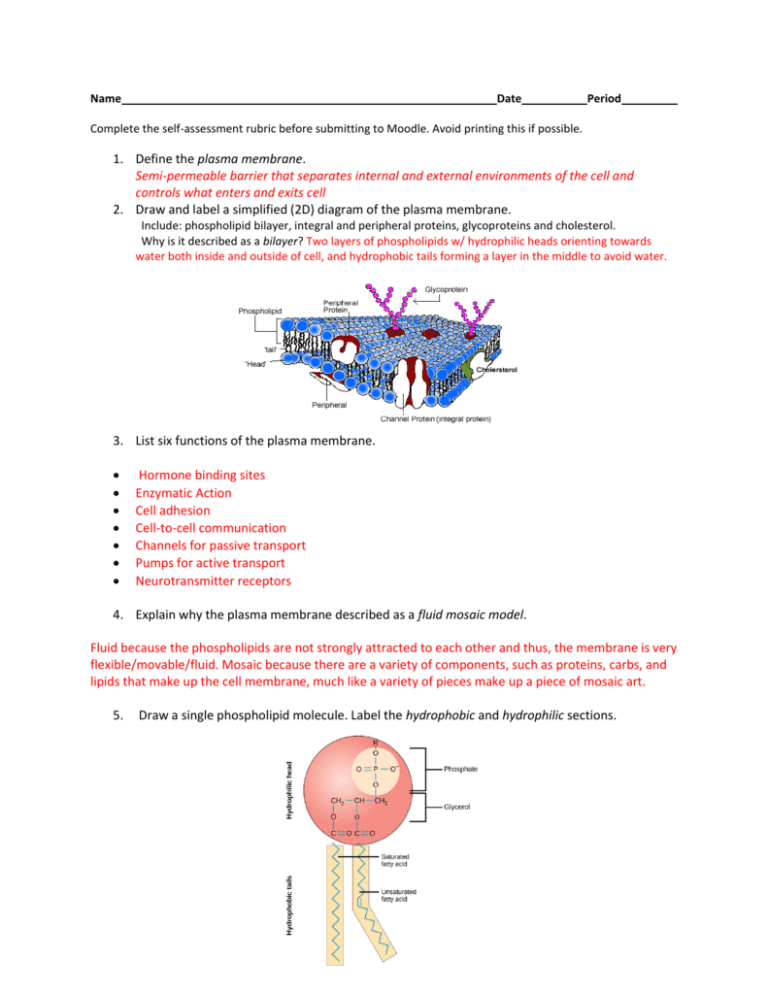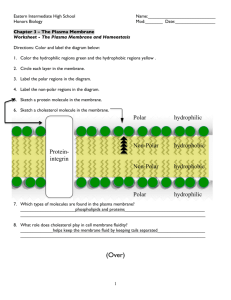1. Define the plasma membrane. Semi
advertisement

Name Date Period Complete the self-assessment rubric before submitting to Moodle. Avoid printing this if possible. 1. Define the plasma membrane. Semi-permeable barrier that separates internal and external environments of the cell and controls what enters and exits cell 2. Draw and label a simplified (2D) diagram of the plasma membrane. Include: phospholipid bilayer, integral and peripheral proteins, glycoproteins and cholesterol. Why is it described as a bilayer? Two layers of phospholipids w/ hydrophilic heads orienting towards water both inside and outside of cell, and hydrophobic tails forming a layer in the middle to avoid water. 3. List six functions of the plasma membrane. Hormone binding sites Enzymatic Action Cell adhesion Cell-to-cell communication Channels for passive transport Pumps for active transport Neurotransmitter receptors 4. Explain why the plasma membrane described as a fluid mosaic model. Fluid because the phospholipids are not strongly attracted to each other and thus, the membrane is very flexible/movable/fluid. Mosaic because there are a variety of components, such as proteins, carbs, and lipids that make up the cell membrane, much like a variety of pieces make up a piece of mosaic art. 5. Draw a single phospholipid molecule. Label the hydrophobic and hydrophilic sections. 6. Explain how hydrophobic and hydrophilic properties of the phospholipid bilayer allow a membrane to maintain its structure. Phospholipids contain both hydrophilic phosphate heads and hydrophobic fatty acid tails. The heads are attracted towards water and the tails repel water. So the heads orient themselves towards the aqueous solutions both inside and outside of the cell, while the tails for a layer in between the heads that repels water. This creates a natural barrier that separates the internal and external environments of the cell. 7. State the functions of these plasma membrane components. a. Glycoproteins – function as hormone binding sites as well as a means of recognizing other cells, and being recognize by other cells. b. Cholesterol – maintains fluidity and stability of phospholipid bilayer 8. Match the following membrane proteins with their functions: Channel/ carrier proteins (D) (A) used in cell surface reactions Protein pumps (E) (B) binding cells together Receptor proteins (F) (C) communication between cells Enzymes (A) (D) passive transport across the membrane Adhesion proteins (B) (E) active transport across the membrane Neurotransmitter receptors (C) (F) hormone binding and recognition 9. Define diffusion. Tendency of molecules to move down their concentration gradients (from high concentration to low concentration) across a cell membrane without using energy. Define osmosis. Passive transport of water across a cell membrane from low solute concentration to high solute concentration. 10. Distinguish between solute, solvent and solution. Solute – molecules dissolved in a solution Solvent – molecule that dissolves the solute (typically water) Solution – homogenous mixture of two or more molecules, where a solute is dissolved in a solvent. 11. Outline the conditions required for the following methods of membrane transport: Concentration gradient Selectively permeable membrane. Membrane proteins ATP (source of energy) Simple diffusion yes Yes no no Osmosis Yes Yes No No Facilitated diffusion Yes yes Yes No Active transport Yes yes Yes Yes 12. Explain what is happening in this diagram: In the u-shaped test tube, there are more solutes on the right side of the permeable membrane than the left, so the process of osmosis is taking place. In osmosis, water is moving from areas of low solute concentration to areas of high solute concentration. So, water is moving from the left side of the testtube, where there are less solutes, to the right side of the test tube, where there are more solutes. 13. Annotate the diagram below to show how a protein pump is used in active transport of molecules across a plasma membrane. The Na+/K+ pump is an example. 3 1 4 5 6 2 1) Sodium ions are binding to the sodium/potassium pump. 2) ATP molecules are phosphorylates, where a phosphate breaks off, releases energy, and binds to the sodium potassium pump. 3) the binding of the phosphate stimulates the pump to change shapes and open to the outside of the cell, thus releasing the sodium ions outside the cell, and moving them from low to high concentration. 4) Potassium ions outside of the cell bind to the pump. 5) the binding of potassium stimulates the release of the phosphate group. 6) the release of the phosphate group causes the pump to return to its original shape and open to the inside of the cell, thus releasing potassium into the cell, against its concentration gradient. 14. Define macromolecule. Give one example of a macromolecule produced in the cell. Large molecules necessary to support life, composed of many smaller units, called monomers. Proteins are made in the cell. 15. Define vesicle. Membrane-bound transport organelles. 16. Distinguish between exocytosis and endocytosis. Endocytosis is the process in which cells bring in a large molecule from outside the cell. A pocket forms on the cell membrane around a large molecule, which then pinches off and brings a large molecule into the cell, using a vesicle formed from the membrane. Exocytosis is the process cells use to expel large molecules made inside of the cell. Proteins are made in and transported to the Golgi Apparatus, where they are modified and placed in vesicles. The vesicles fuse with the plasma membrane and then release/expel their contents outside of the cell. 17. Describe how the plasma membrane breaks and reforms during exocytosis and endocytosis. How does the fluidity of the membrane allow this? The fluidity of the phospholipids, meaning that they are not closely attracted to each other, allows for the fusion of vesicle membranes and cell membranes. The stability (hydrophobic and hydrophilic interactions) of the phospholipids maintain a barrier between the inside and outside of the cell. So, when a cell pinches off, the vesicle can break away from the membrane because of the fluidity of the membranes, and the stability maintains the barrier between the two sides.








